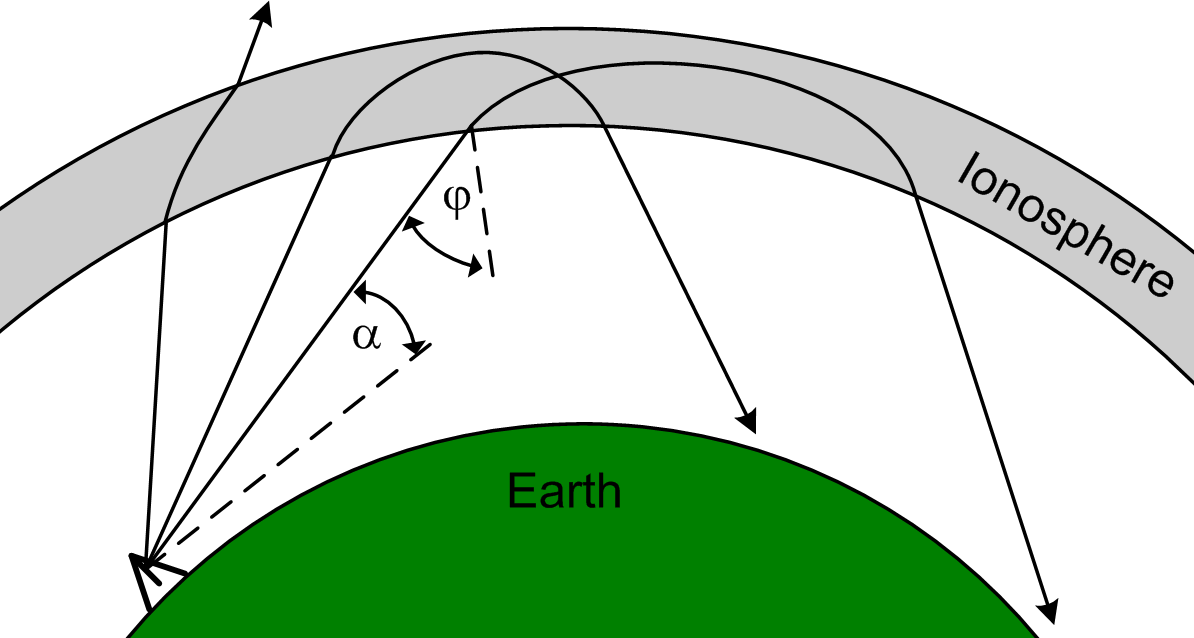
The ionospheric layer acts as a reflector for the frequency range:
A) $1\,KHz$ to $10\,KHz$
B) $3$ to $30\,MHz$
C) $100\,KHz$ to $1\,MHz$
D) $3\,GHz$ to $30\,GHz$
Answer
138.9k+ views
Hint: The atmospheric layer of the earth is divided into many layers depending on its nature. They include the troposphere, stratosphere, mesosphere, thermosphere, ionosphere and the exosphere. All these layers together are called the atmosphere.
Complete step by step solution:
The ionosphere is the layer of the earth that is the ionized part starting from the distance of the $48\,Km$ from the earth surface and extends up to the $965\,Km$. The ionosphere layer is of three types as $D$ layer, $E$ layer and the $F$ layer based on the wavelength of the absorbed solar radiation. Out of which the $D$ ionospheric layer located at the bottom, $E$ ionospheric layer at the middle and both interfere with the thermosphere and the mesosphere.

The $F$ ionospheric layer at the top. This layer is provided with the abundant number of the electrons along with the ionized molecules and the atoms. This layer of ionosphere reflects the light waves that are within the frequency range of $3$ to $30\,MHz$ . Above or below this range, may pass through it.
Thus the option (B) is correct.
Note: The atoms and the molecules present in the ionosphere get ionized by the solar radiations from the sun. Hence they conduct the electricity. Due to the process of ionization, this layer of the atmosphere is with a higher temperature.
Complete step by step solution:
The ionosphere is the layer of the earth that is the ionized part starting from the distance of the $48\,Km$ from the earth surface and extends up to the $965\,Km$. The ionosphere layer is of three types as $D$ layer, $E$ layer and the $F$ layer based on the wavelength of the absorbed solar radiation. Out of which the $D$ ionospheric layer located at the bottom, $E$ ionospheric layer at the middle and both interfere with the thermosphere and the mesosphere.

The $F$ ionospheric layer at the top. This layer is provided with the abundant number of the electrons along with the ionized molecules and the atoms. This layer of ionosphere reflects the light waves that are within the frequency range of $3$ to $30\,MHz$ . Above or below this range, may pass through it.
Thus the option (B) is correct.
Note: The atoms and the molecules present in the ionosphere get ionized by the solar radiations from the sun. Hence they conduct the electricity. Due to the process of ionization, this layer of the atmosphere is with a higher temperature.
Recently Updated Pages
Young's Double Slit Experiment Step by Step Derivation

How to find Oxidation Number - Important Concepts for JEE

How Electromagnetic Waves are Formed - Important Concepts for JEE

Electrical Resistance - Important Concepts and Tips for JEE

Average Atomic Mass - Important Concepts and Tips for JEE

Chemical Equation - Important Concepts and Tips for JEE

Trending doubts
JEE Main 2025 Session 2: Application Form (Out), Exam Dates (Released), Eligibility, & More

JEE Main 2025: Derivation of Equation of Trajectory in Physics

Learn About Angle Of Deviation In Prism: JEE Main Physics 2025

Electric Field Due to Uniformly Charged Ring for JEE Main 2025 - Formula and Derivation

JEE Main 2025: Conversion of Galvanometer Into Ammeter And Voltmeter in Physics

Degree of Dissociation and Its Formula With Solved Example for JEE

Other Pages
JEE Advanced Marks vs Ranks 2025: Understanding Category-wise Qualifying Marks and Previous Year Cut-offs

Electric field due to uniformly charged sphere class 12 physics JEE_Main

Physics Average Value and RMS Value JEE Main 2025

Dual Nature of Radiation and Matter Class 12 Notes: CBSE Physics Chapter 11

Formula for number of images formed by two plane mirrors class 12 physics JEE_Main

Charging and Discharging of Capacitor




